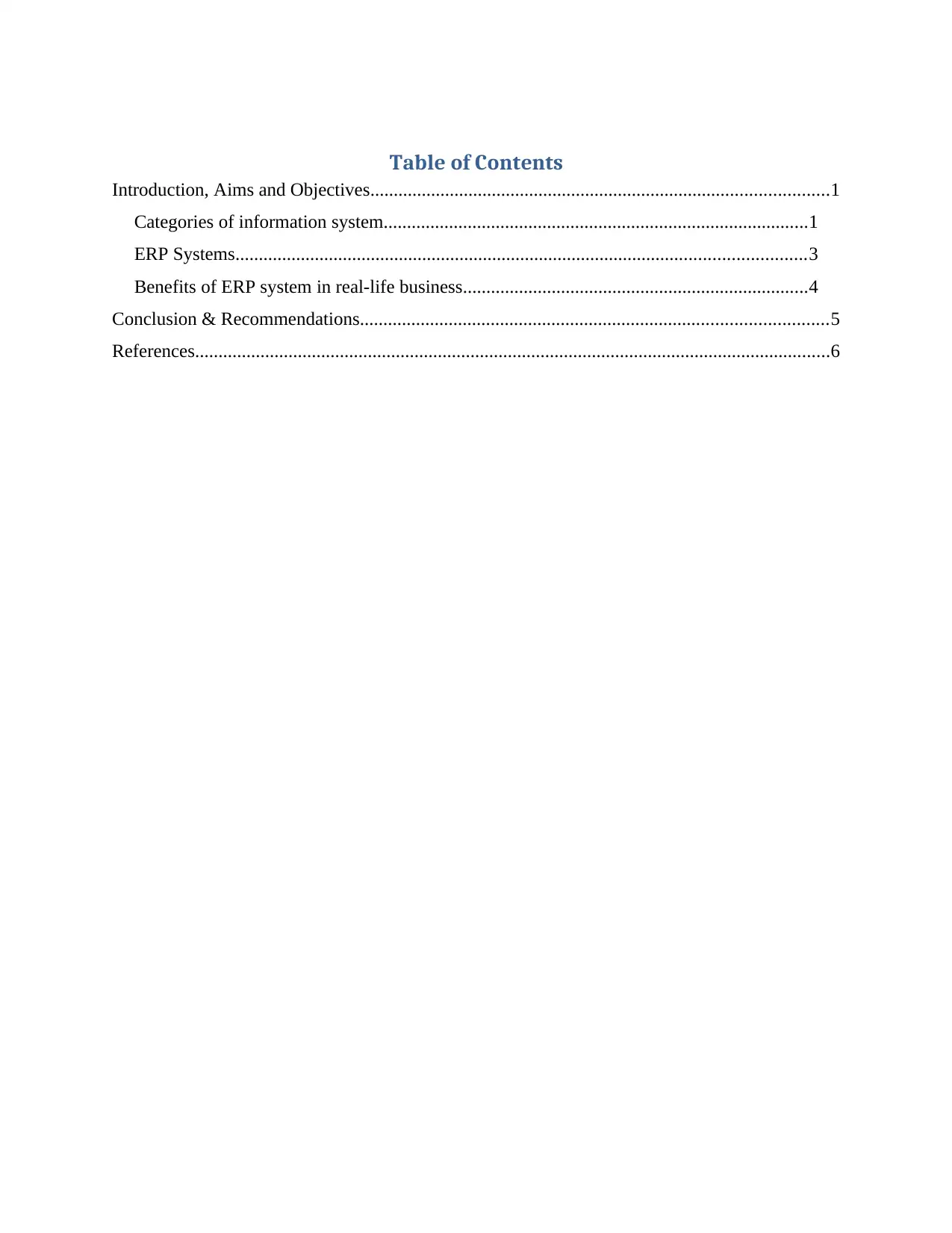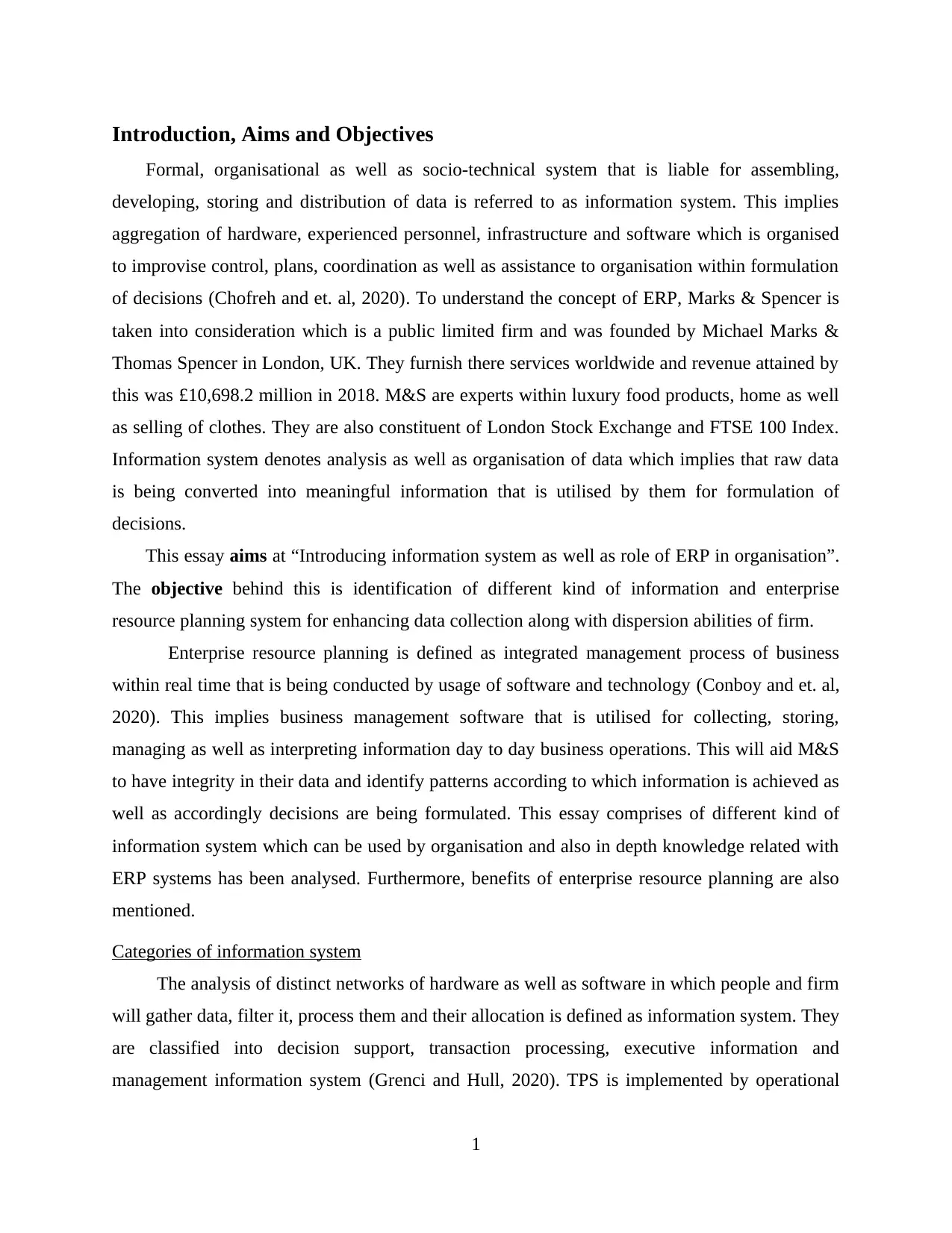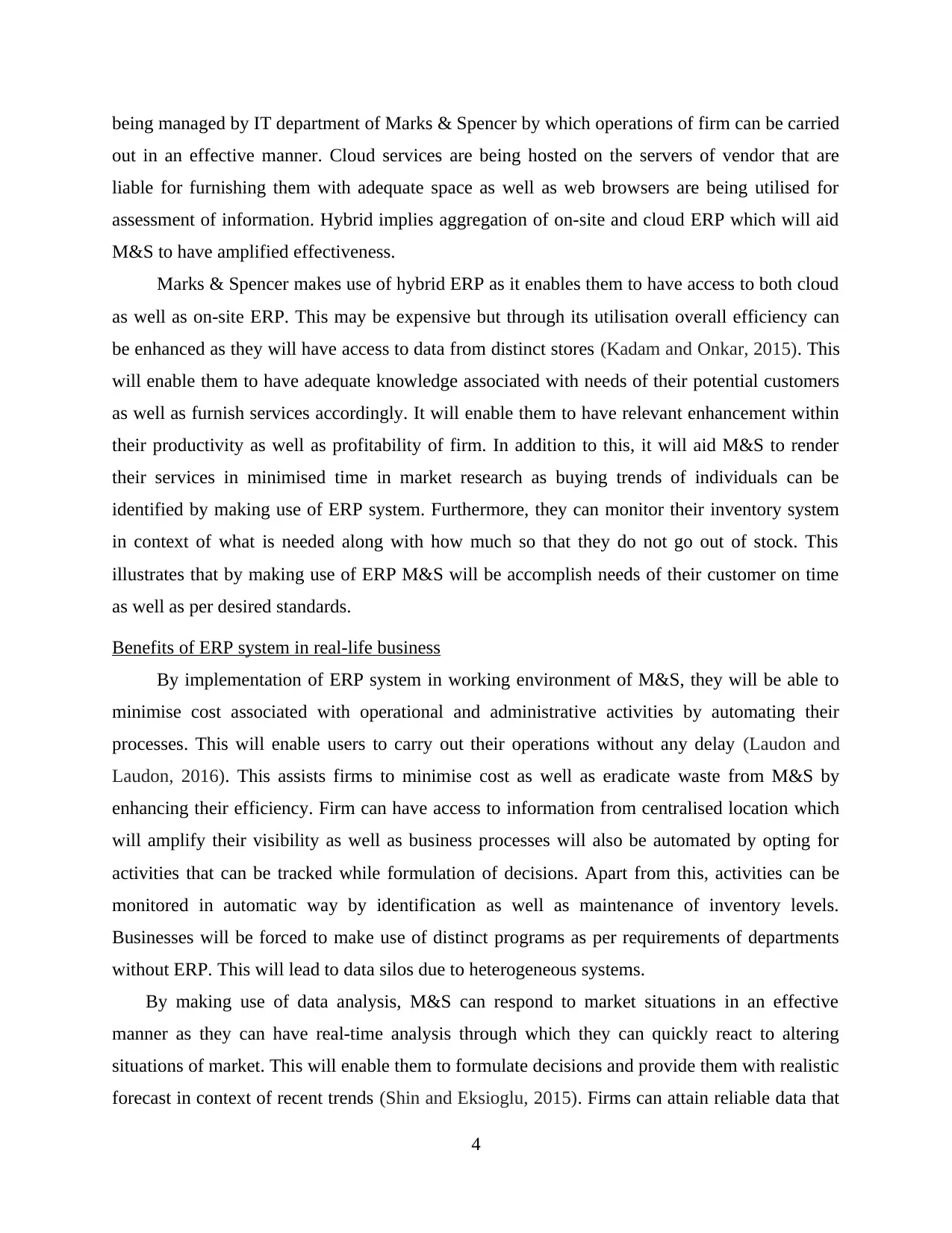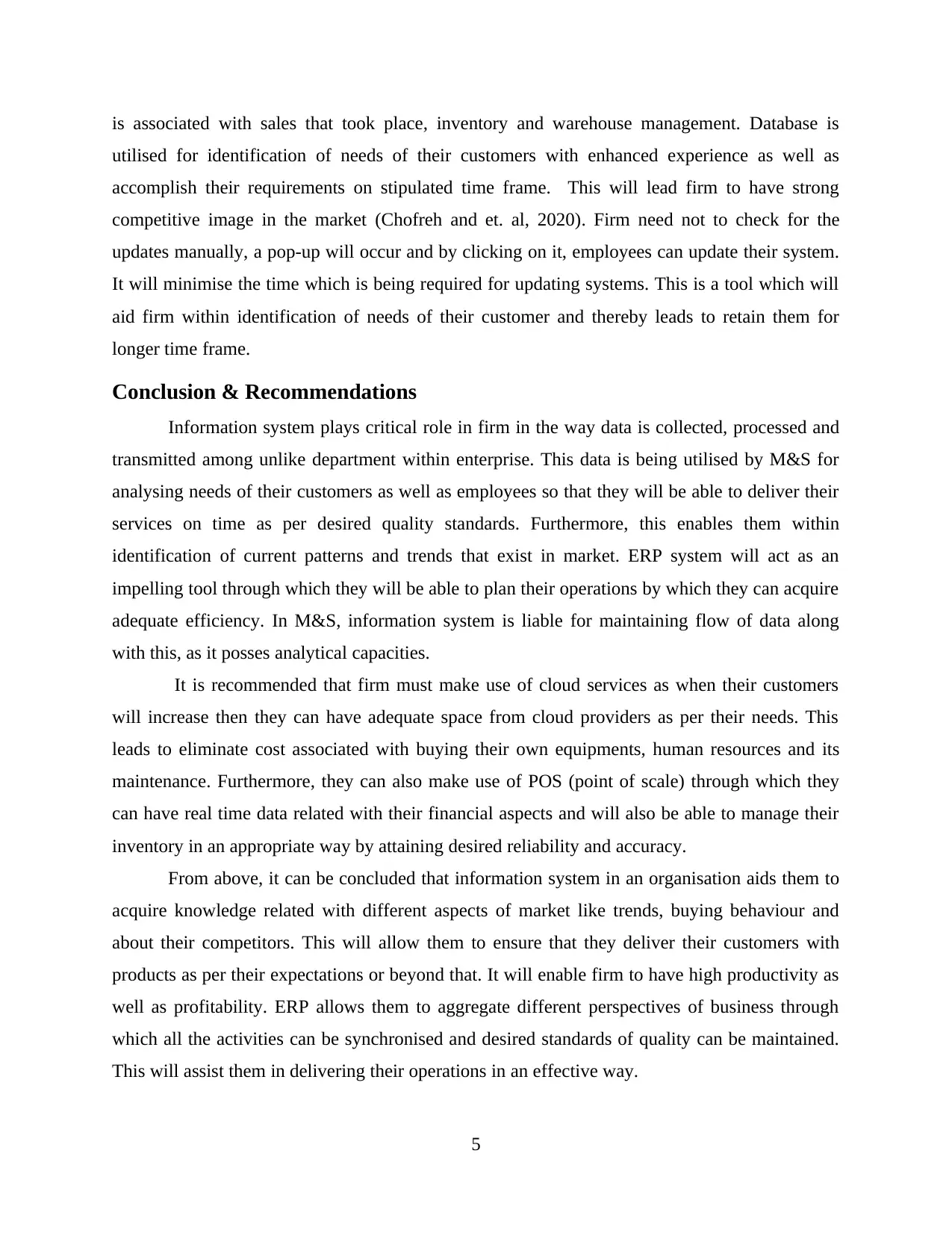Role of ERP in Organization
VerifiedAdded on 2023/01/12
|9
|2714
|89
AI Summary
This essay explores the role of ERP in organizations and its benefits in real-life business. It discusses different categories of information systems and the implementation of ERP systems. The essay also provides recommendations for organizations to optimize their ERP systems.
Contribute Materials
Your contribution can guide someone’s learning journey. Share your
documents today.

ERP
Secure Best Marks with AI Grader
Need help grading? Try our AI Grader for instant feedback on your assignments.

Table of Contents
Introduction, Aims and Objectives..................................................................................................1
Categories of information system...........................................................................................1
ERP Systems..........................................................................................................................3
Benefits of ERP system in real-life business..........................................................................4
Conclusion & Recommendations....................................................................................................5
References........................................................................................................................................6
Introduction, Aims and Objectives..................................................................................................1
Categories of information system...........................................................................................1
ERP Systems..........................................................................................................................3
Benefits of ERP system in real-life business..........................................................................4
Conclusion & Recommendations....................................................................................................5
References........................................................................................................................................6


Introduction, Aims and Objectives
Formal, organisational as well as socio-technical system that is liable for assembling,
developing, storing and distribution of data is referred to as information system. This implies
aggregation of hardware, experienced personnel, infrastructure and software which is organised
to improvise control, plans, coordination as well as assistance to organisation within formulation
of decisions (Chofreh and et. al, 2020). To understand the concept of ERP, Marks & Spencer is
taken into consideration which is a public limited firm and was founded by Michael Marks &
Thomas Spencer in London, UK. They furnish there services worldwide and revenue attained by
this was £10,698.2 million in 2018. M&S are experts within luxury food products, home as well
as selling of clothes. They are also constituent of London Stock Exchange and FTSE 100 Index.
Information system denotes analysis as well as organisation of data which implies that raw data
is being converted into meaningful information that is utilised by them for formulation of
decisions.
This essay aims at “Introducing information system as well as role of ERP in organisation”.
The objective behind this is identification of different kind of information and enterprise
resource planning system for enhancing data collection along with dispersion abilities of firm.
Enterprise resource planning is defined as integrated management process of business
within real time that is being conducted by usage of software and technology (Conboy and et. al,
2020). This implies business management software that is utilised for collecting, storing,
managing as well as interpreting information day to day business operations. This will aid M&S
to have integrity in their data and identify patterns according to which information is achieved as
well as accordingly decisions are being formulated. This essay comprises of different kind of
information system which can be used by organisation and also in depth knowledge related with
ERP systems has been analysed. Furthermore, benefits of enterprise resource planning are also
mentioned.
Categories of information system
The analysis of distinct networks of hardware as well as software in which people and firm
will gather data, filter it, process them and their allocation is defined as information system. They
are classified into decision support, transaction processing, executive information and
management information system (Grenci and Hull, 2020). TPS is implemented by operational
1
Formal, organisational as well as socio-technical system that is liable for assembling,
developing, storing and distribution of data is referred to as information system. This implies
aggregation of hardware, experienced personnel, infrastructure and software which is organised
to improvise control, plans, coordination as well as assistance to organisation within formulation
of decisions (Chofreh and et. al, 2020). To understand the concept of ERP, Marks & Spencer is
taken into consideration which is a public limited firm and was founded by Michael Marks &
Thomas Spencer in London, UK. They furnish there services worldwide and revenue attained by
this was £10,698.2 million in 2018. M&S are experts within luxury food products, home as well
as selling of clothes. They are also constituent of London Stock Exchange and FTSE 100 Index.
Information system denotes analysis as well as organisation of data which implies that raw data
is being converted into meaningful information that is utilised by them for formulation of
decisions.
This essay aims at “Introducing information system as well as role of ERP in organisation”.
The objective behind this is identification of different kind of information and enterprise
resource planning system for enhancing data collection along with dispersion abilities of firm.
Enterprise resource planning is defined as integrated management process of business
within real time that is being conducted by usage of software and technology (Conboy and et. al,
2020). This implies business management software that is utilised for collecting, storing,
managing as well as interpreting information day to day business operations. This will aid M&S
to have integrity in their data and identify patterns according to which information is achieved as
well as accordingly decisions are being formulated. This essay comprises of different kind of
information system which can be used by organisation and also in depth knowledge related with
ERP systems has been analysed. Furthermore, benefits of enterprise resource planning are also
mentioned.
Categories of information system
The analysis of distinct networks of hardware as well as software in which people and firm
will gather data, filter it, process them and their allocation is defined as information system. They
are classified into decision support, transaction processing, executive information and
management information system (Grenci and Hull, 2020). TPS is implemented by operational
1
Secure Best Marks with AI Grader
Need help grading? Try our AI Grader for instant feedback on your assignments.

level systems at bottom of pyramid. These activities are being carried out by floor workers or
line staff that aids within supporting within management of activities that are carried out by
organisation. The data is being collected by making use of automated and semi-automated
tracking for carrying out basic activities as well as transactions that are conducted at low level.
Front line employees within Marks & Spencer are liable for computing, updating, integrating,
listing, cataloguing and authenticating them. For an instance, they comprises of payroll system,
order processing and many others.
MIS (Management Information System) denotes monitoring the performance positioning
of organisation. Results that are being achieved from TPS (Transaction Processing System) acts
like input or effort for MIS. Within Marks & Spencer, such kind of systems are being utilised by
tactical managers for carrying out internal transactions, integrating internal files along with
summarising the structured and systematic information (More, 2020). For an instance, it includes
management reporting system, inventory control system and various other aspects. With
reference to this, data is being converted from internal and external sources of information that is
being disseminated in between managers for furnishing their activities in an efficacious and
précised manner. Management of Marks & Spencer can determine current performance of
organisation in context of their previous performance.
DSS (Decision Support System) act like a knowledge based system that is liable for them
for creating information as well as merging it with different functionalities that are being
conducted by firm. In Marks & Spencer, such kind of systems are being utilised by senior
managers for carrying out analysis of existing structured information as well as insight can be
attained by evaluation of influence of decisions which is being made by them in context of future
(Volkoff, 2020). With respect to this, modelling and simulation is being conducted in the form of
internal transaction, external information and files are being analysed which are in summarised
form. For an example, it involves financial, logistic planning and many other aspects. This is
anticipated in context of decision making for tactical as well as strategic terms. DSS involves
summary of data that is intense from data that is being collected from external sources, data
processing system and management information system. Analytical model, rule of business
within decision table, forecasting & planning tools as well as rules designed for the same.
EIS (Executive Information System) is utilised for carrying out analysis of environment
in which firm conducts their operations through which they can determine trends that prevails
2
line staff that aids within supporting within management of activities that are carried out by
organisation. The data is being collected by making use of automated and semi-automated
tracking for carrying out basic activities as well as transactions that are conducted at low level.
Front line employees within Marks & Spencer are liable for computing, updating, integrating,
listing, cataloguing and authenticating them. For an instance, they comprises of payroll system,
order processing and many others.
MIS (Management Information System) denotes monitoring the performance positioning
of organisation. Results that are being achieved from TPS (Transaction Processing System) acts
like input or effort for MIS. Within Marks & Spencer, such kind of systems are being utilised by
tactical managers for carrying out internal transactions, integrating internal files along with
summarising the structured and systematic information (More, 2020). For an instance, it includes
management reporting system, inventory control system and various other aspects. With
reference to this, data is being converted from internal and external sources of information that is
being disseminated in between managers for furnishing their activities in an efficacious and
précised manner. Management of Marks & Spencer can determine current performance of
organisation in context of their previous performance.
DSS (Decision Support System) act like a knowledge based system that is liable for them
for creating information as well as merging it with different functionalities that are being
conducted by firm. In Marks & Spencer, such kind of systems are being utilised by senior
managers for carrying out analysis of existing structured information as well as insight can be
attained by evaluation of influence of decisions which is being made by them in context of future
(Volkoff, 2020). With respect to this, modelling and simulation is being conducted in the form of
internal transaction, external information and files are being analysed which are in summarised
form. For an example, it involves financial, logistic planning and many other aspects. This is
anticipated in context of decision making for tactical as well as strategic terms. DSS involves
summary of data that is intense from data that is being collected from external sources, data
processing system and management information system. Analytical model, rule of business
within decision table, forecasting & planning tools as well as rules designed for the same.
EIS (Executive Information System) is utilised for carrying out analysis of environment
in which firm conducts their operations through which they can determine trends that prevails
2

within the market for development of appropriate set of functions. In Marks & Spencer, data is
organised weakly from both external and internal sources. This is being implemented by
executives without any intermediaries that can be maintained according to needs of their
probable customers (Fernie and Sparks, 2018). External data is in a summarised form and
simulation of internal files is carried out to analyse overall impact on the operations of
organisation. They are associated with ease of utilisation through which forecasting with respect
to future is carried out with higher flexibility. For an instance, it is being utilised by group of
people or individuals. They are liable for merging data with external entities such as tax laws,
competitors, etc. Compressed data is collected from internal MIS as well as DSS. By making use
of these information systems, M&S can attain data associated with competitors and their
customers through which competitive edge will be attained among their rivals.
ERP Systems
The automation as well as amalgamation of core operations of firm through which they can
assistance for emphasising on efficaciousness of success is referred to as enterprise resource
planning (Garg and Chauhan, 2015). For understanding this concept an instance can be taken
into consideration like by making use of integrated and automatic integrated processes which are
being made by their customers that will be monitored as well as details associated with services
can be effectively achieved. The other instances include scheduling of operations, inventory
control along with management of financial aspects. ERP system will render facilities to M&S
through which overall performance of their system can be enhanced. This enables them to have
analytics, intelligence, visibility and efficiency for each aspect of their business. It implies
integrated system that is being utilised by firm for managing and automating there all operations
which are conducted at back office. This is business management software that makes
interpretations in context of real time decision making.
Enterprise resource planning is liable for merging processes that involves supply chain,
sales, marketing and procurement of raw materials. M&S utilises ERP for rendering their
workforce with shared database so that they can have access to it as per their needs. This will
lead them to minimise errors as well as duplication of information through which inefficiencies
can be eradicated (Hübner, Wollenburg and Holzapfel, 2016). There are distinct kinds of ERP
systems which can be used by organisation they are, cloud, traditional or on-premises software
and hybrid. There database is either present on the on-site servers and hardware. This system is
3
organised weakly from both external and internal sources. This is being implemented by
executives without any intermediaries that can be maintained according to needs of their
probable customers (Fernie and Sparks, 2018). External data is in a summarised form and
simulation of internal files is carried out to analyse overall impact on the operations of
organisation. They are associated with ease of utilisation through which forecasting with respect
to future is carried out with higher flexibility. For an instance, it is being utilised by group of
people or individuals. They are liable for merging data with external entities such as tax laws,
competitors, etc. Compressed data is collected from internal MIS as well as DSS. By making use
of these information systems, M&S can attain data associated with competitors and their
customers through which competitive edge will be attained among their rivals.
ERP Systems
The automation as well as amalgamation of core operations of firm through which they can
assistance for emphasising on efficaciousness of success is referred to as enterprise resource
planning (Garg and Chauhan, 2015). For understanding this concept an instance can be taken
into consideration like by making use of integrated and automatic integrated processes which are
being made by their customers that will be monitored as well as details associated with services
can be effectively achieved. The other instances include scheduling of operations, inventory
control along with management of financial aspects. ERP system will render facilities to M&S
through which overall performance of their system can be enhanced. This enables them to have
analytics, intelligence, visibility and efficiency for each aspect of their business. It implies
integrated system that is being utilised by firm for managing and automating there all operations
which are conducted at back office. This is business management software that makes
interpretations in context of real time decision making.
Enterprise resource planning is liable for merging processes that involves supply chain,
sales, marketing and procurement of raw materials. M&S utilises ERP for rendering their
workforce with shared database so that they can have access to it as per their needs. This will
lead them to minimise errors as well as duplication of information through which inefficiencies
can be eradicated (Hübner, Wollenburg and Holzapfel, 2016). There are distinct kinds of ERP
systems which can be used by organisation they are, cloud, traditional or on-premises software
and hybrid. There database is either present on the on-site servers and hardware. This system is
3

being managed by IT department of Marks & Spencer by which operations of firm can be carried
out in an effective manner. Cloud services are being hosted on the servers of vendor that are
liable for furnishing them with adequate space as well as web browsers are being utilised for
assessment of information. Hybrid implies aggregation of on-site and cloud ERP which will aid
M&S to have amplified effectiveness.
Marks & Spencer makes use of hybrid ERP as it enables them to have access to both cloud
as well as on-site ERP. This may be expensive but through its utilisation overall efficiency can
be enhanced as they will have access to data from distinct stores (Kadam and Onkar, 2015). This
will enable them to have adequate knowledge associated with needs of their potential customers
as well as furnish services accordingly. It will enable them to have relevant enhancement within
their productivity as well as profitability of firm. In addition to this, it will aid M&S to render
their services in minimised time in market research as buying trends of individuals can be
identified by making use of ERP system. Furthermore, they can monitor their inventory system
in context of what is needed along with how much so that they do not go out of stock. This
illustrates that by making use of ERP M&S will be accomplish needs of their customer on time
as well as per desired standards.
Benefits of ERP system in real-life business
By implementation of ERP system in working environment of M&S, they will be able to
minimise cost associated with operational and administrative activities by automating their
processes. This will enable users to carry out their operations without any delay (Laudon and
Laudon, 2016). This assists firms to minimise cost as well as eradicate waste from M&S by
enhancing their efficiency. Firm can have access to information from centralised location which
will amplify their visibility as well as business processes will also be automated by opting for
activities that can be tracked while formulation of decisions. Apart from this, activities can be
monitored in automatic way by identification as well as maintenance of inventory levels.
Businesses will be forced to make use of distinct programs as per requirements of departments
without ERP. This will lead to data silos due to heterogeneous systems.
By making use of data analysis, M&S can respond to market situations in an effective
manner as they can have real-time analysis through which they can quickly react to altering
situations of market. This will enable them to formulate decisions and provide them with realistic
forecast in context of recent trends (Shin and Eksioglu, 2015). Firms can attain reliable data that
4
out in an effective manner. Cloud services are being hosted on the servers of vendor that are
liable for furnishing them with adequate space as well as web browsers are being utilised for
assessment of information. Hybrid implies aggregation of on-site and cloud ERP which will aid
M&S to have amplified effectiveness.
Marks & Spencer makes use of hybrid ERP as it enables them to have access to both cloud
as well as on-site ERP. This may be expensive but through its utilisation overall efficiency can
be enhanced as they will have access to data from distinct stores (Kadam and Onkar, 2015). This
will enable them to have adequate knowledge associated with needs of their potential customers
as well as furnish services accordingly. It will enable them to have relevant enhancement within
their productivity as well as profitability of firm. In addition to this, it will aid M&S to render
their services in minimised time in market research as buying trends of individuals can be
identified by making use of ERP system. Furthermore, they can monitor their inventory system
in context of what is needed along with how much so that they do not go out of stock. This
illustrates that by making use of ERP M&S will be accomplish needs of their customer on time
as well as per desired standards.
Benefits of ERP system in real-life business
By implementation of ERP system in working environment of M&S, they will be able to
minimise cost associated with operational and administrative activities by automating their
processes. This will enable users to carry out their operations without any delay (Laudon and
Laudon, 2016). This assists firms to minimise cost as well as eradicate waste from M&S by
enhancing their efficiency. Firm can have access to information from centralised location which
will amplify their visibility as well as business processes will also be automated by opting for
activities that can be tracked while formulation of decisions. Apart from this, activities can be
monitored in automatic way by identification as well as maintenance of inventory levels.
Businesses will be forced to make use of distinct programs as per requirements of departments
without ERP. This will lead to data silos due to heterogeneous systems.
By making use of data analysis, M&S can respond to market situations in an effective
manner as they can have real-time analysis through which they can quickly react to altering
situations of market. This will enable them to formulate decisions and provide them with realistic
forecast in context of recent trends (Shin and Eksioglu, 2015). Firms can attain reliable data that
4
Paraphrase This Document
Need a fresh take? Get an instant paraphrase of this document with our AI Paraphraser

is associated with sales that took place, inventory and warehouse management. Database is
utilised for identification of needs of their customers with enhanced experience as well as
accomplish their requirements on stipulated time frame. This will lead firm to have strong
competitive image in the market (Chofreh and et. al, 2020). Firm need not to check for the
updates manually, a pop-up will occur and by clicking on it, employees can update their system.
It will minimise the time which is being required for updating systems. This is a tool which will
aid firm within identification of needs of their customer and thereby leads to retain them for
longer time frame.
Conclusion & Recommendations
Information system plays critical role in firm in the way data is collected, processed and
transmitted among unlike department within enterprise. This data is being utilised by M&S for
analysing needs of their customers as well as employees so that they will be able to deliver their
services on time as per desired quality standards. Furthermore, this enables them within
identification of current patterns and trends that exist in market. ERP system will act as an
impelling tool through which they will be able to plan their operations by which they can acquire
adequate efficiency. In M&S, information system is liable for maintaining flow of data along
with this, as it posses analytical capacities.
It is recommended that firm must make use of cloud services as when their customers
will increase then they can have adequate space from cloud providers as per their needs. This
leads to eliminate cost associated with buying their own equipments, human resources and its
maintenance. Furthermore, they can also make use of POS (point of scale) through which they
can have real time data related with their financial aspects and will also be able to manage their
inventory in an appropriate way by attaining desired reliability and accuracy.
From above, it can be concluded that information system in an organisation aids them to
acquire knowledge related with different aspects of market like trends, buying behaviour and
about their competitors. This will allow them to ensure that they deliver their customers with
products as per their expectations or beyond that. It will enable firm to have high productivity as
well as profitability. ERP allows them to aggregate different perspectives of business through
which all the activities can be synchronised and desired standards of quality can be maintained.
This will assist them in delivering their operations in an effective way.
5
utilised for identification of needs of their customers with enhanced experience as well as
accomplish their requirements on stipulated time frame. This will lead firm to have strong
competitive image in the market (Chofreh and et. al, 2020). Firm need not to check for the
updates manually, a pop-up will occur and by clicking on it, employees can update their system.
It will minimise the time which is being required for updating systems. This is a tool which will
aid firm within identification of needs of their customer and thereby leads to retain them for
longer time frame.
Conclusion & Recommendations
Information system plays critical role in firm in the way data is collected, processed and
transmitted among unlike department within enterprise. This data is being utilised by M&S for
analysing needs of their customers as well as employees so that they will be able to deliver their
services on time as per desired quality standards. Furthermore, this enables them within
identification of current patterns and trends that exist in market. ERP system will act as an
impelling tool through which they will be able to plan their operations by which they can acquire
adequate efficiency. In M&S, information system is liable for maintaining flow of data along
with this, as it posses analytical capacities.
It is recommended that firm must make use of cloud services as when their customers
will increase then they can have adequate space from cloud providers as per their needs. This
leads to eliminate cost associated with buying their own equipments, human resources and its
maintenance. Furthermore, they can also make use of POS (point of scale) through which they
can have real time data related with their financial aspects and will also be able to manage their
inventory in an appropriate way by attaining desired reliability and accuracy.
From above, it can be concluded that information system in an organisation aids them to
acquire knowledge related with different aspects of market like trends, buying behaviour and
about their competitors. This will allow them to ensure that they deliver their customers with
products as per their expectations or beyond that. It will enable firm to have high productivity as
well as profitability. ERP allows them to aggregate different perspectives of business through
which all the activities can be synchronised and desired standards of quality can be maintained.
This will assist them in delivering their operations in an effective way.
5

References
Books and Journals
Chofreh, A.G. and et. al, 2020. Development of guidelines for the implementation of sustainable
enterprise resource planning systems. Journal of Cleaner Production, 244, p.118655.
Conboy, K. And et. al, 2020. Using business analytics to enhance dynamic capabilities in
operations research: A case analysis and research agenda. European Journal of
Operational Research, 281(3), pp.656-672.
Grenci, R.T. and Hull, B.Z., 2020. New dog, old tricks: ERP and the systems development life
cycle. Journal of Information Systems Education, 15(3), p.7.
More, E., 2020. opportunity. Work.
Volkoff, O., 2020. Configuring an ERP system: introducing best practices or hampering
flexibility?. Journal of Information Systems Education, 14(3), p.14.
Fernie, J. and Sparks, L. eds., 2018. Logistics and retail management: emerging issues and new
challenges in the retail supply chain. Kogan page publishers.
Garg, P. and Chauhan, A., 2015. Factors affecting the ERP implementation in Indian retail
sector: A structural equation modelling approach. Benchmarking: an International
Journal. 22(7). pp.1315-1340.
Hübner, A., Wollenburg, J. and Holzapfel, A., 2016. Retail logistics in the transition from multi-
channel to omni-channel. International Journal of Physical Distribution & Logistics
Management. 46(6/7). pp.562-583.
Kadam, K. S. and Onkar, V. C., 2015. A review paper on student information supervision
system. International Journal of Research In Science & Engineering. 1. pp.66-72.
Laudon, K. C. and Laudon, J. P., 2016. Management information system. Pearson Education
India.
Shin, S. and Eksioglu, B., 2015. An empirical study of RFID productivity in the US retail supply
chain. International Journal of Production Economics. 163. pp.89-96.
6
Books and Journals
Chofreh, A.G. and et. al, 2020. Development of guidelines for the implementation of sustainable
enterprise resource planning systems. Journal of Cleaner Production, 244, p.118655.
Conboy, K. And et. al, 2020. Using business analytics to enhance dynamic capabilities in
operations research: A case analysis and research agenda. European Journal of
Operational Research, 281(3), pp.656-672.
Grenci, R.T. and Hull, B.Z., 2020. New dog, old tricks: ERP and the systems development life
cycle. Journal of Information Systems Education, 15(3), p.7.
More, E., 2020. opportunity. Work.
Volkoff, O., 2020. Configuring an ERP system: introducing best practices or hampering
flexibility?. Journal of Information Systems Education, 14(3), p.14.
Fernie, J. and Sparks, L. eds., 2018. Logistics and retail management: emerging issues and new
challenges in the retail supply chain. Kogan page publishers.
Garg, P. and Chauhan, A., 2015. Factors affecting the ERP implementation in Indian retail
sector: A structural equation modelling approach. Benchmarking: an International
Journal. 22(7). pp.1315-1340.
Hübner, A., Wollenburg, J. and Holzapfel, A., 2016. Retail logistics in the transition from multi-
channel to omni-channel. International Journal of Physical Distribution & Logistics
Management. 46(6/7). pp.562-583.
Kadam, K. S. and Onkar, V. C., 2015. A review paper on student information supervision
system. International Journal of Research In Science & Engineering. 1. pp.66-72.
Laudon, K. C. and Laudon, J. P., 2016. Management information system. Pearson Education
India.
Shin, S. and Eksioglu, B., 2015. An empirical study of RFID productivity in the US retail supply
chain. International Journal of Production Economics. 163. pp.89-96.
6
1 out of 9
Related Documents
Your All-in-One AI-Powered Toolkit for Academic Success.
+13062052269
info@desklib.com
Available 24*7 on WhatsApp / Email
![[object Object]](/_next/static/media/star-bottom.7253800d.svg)
Unlock your academic potential
© 2024 | Zucol Services PVT LTD | All rights reserved.





